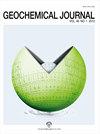Lithium isotope systematics of Arima hot spring waters and groundwaters in Kii Peninsula
IF 1.6
4区 地球科学
Q3 GEOCHEMISTRY & GEOPHYSICS
引用次数: 2
Abstract
14 Slab-dehydrated fluid is considered to be involved in island arc magmatism. In this study, Li 15 isotope ratios were determined for deep groundwater samples from the non-volcanic forearc 16 region of SW Japan. The contribution of the slab-dehydrated fluid from the Philippine Sea 17 Plate (PHS) was investigated in the Arima area and the eastern Kii Peninsula area, 18 corresponding to the slab depths of ~60 km and 20-30 km, respectively. In the Arima area, the 19 high-temperature thermal waters with high salinity called the Arima-type fluid were clarified 20 to have low δ 7 Li values of +1-+3‰. The low δ 7 Li values with high Li concentrations are 21 thought to be the result of fluid-rock interactions at high temperatures, which is consistent 22 with the characteristics of the slab-dehydrated fluid. On the other hand, the δ 7 Li values of 23 deep groundwaters in the eastern Kii Peninsula showed a wide range of +2 to +29‰. Several 24 groundwater samples had a similar chemical property to the Arima-type fluid: low δ 7 Li 25 values, low Cl/Li ratios, and 87 Sr/ 86 Sr ratios around 0.708-0.710. They are distributed along 26 the Median Tectonic Line (MTL) and within about 20 km south of the MTL. These results indicate a common supply of slab-dehydrated fluids to the non-volcanic forearc region in SW 28 Japan from PHS along the large faults, and Li isotope ratios will be a useful indicator to detect their contribution.Kii半岛阿里马温泉和地下水的锂同位素系统
14板状脱水流体被认为与岛弧岩浆活动有关。本文对日本西南部非火山弧前地区深层地下水样品进行了Li - 15同位素比值测定。在Arima地区和Kii半岛东部地区,分别研究了来自菲律宾海17板块(PHS)的板状脱水流体的贡献,分别对应于板状深度为~60 km和20 ~ 30 km。在Arima地区,澄清了19个高矿化度高温热液,称为Arima型流体,δ 7 Li值较低,为+1 ~ +3‰。低δ 7 Li值和高Li浓度21被认为是高温下流体-岩石相互作用的结果,这与板状脱水流体的特征一致。另一方面,Kii半岛东部23个深层地下水δ 7 Li值在+2 ~ +29‰范围内变化较大。24份地下水样品具有与arima型流体相似的化学性质:δ 7 Li 25值低,Cl/Li比值低,87 Sr/ 86 Sr比值在0.708 ~ 0.710之间。它们分布在中构造线(MTL) 26沿线和MTL以南约20公里范围内。这些结果表明,日本西南28地区的非火山前弧区普遍存在由PHS沿大断裂输送的板状脱水流体,而Li同位素比值将是检测其贡献的有用指标。
本文章由计算机程序翻译,如有差异,请以英文原文为准。
求助全文
约1分钟内获得全文
求助全文
来源期刊

Geochemical Journal
地学-地球化学与地球物理
CiteScore
1.70
自引率
12.50%
发文量
11
审稿时长
6 months
期刊介绍:
Geochemical Journal is an international journal devoted to original research papers in geochemistry and cosmochemistry. It is the primary journal of the Geochemical Society of Japan. Areas of research are as follows:
Cosmochemistry; Mineral and Rock Chemistry; Volcanology and Hydrothermal Chemistry; Isotope Geochemistry and Geochronology; Atmospheric Chemistry; Hydro- and Marine Chemistry; Organic Geochemistry; Environmental Chemistry.
 求助内容:
求助内容: 应助结果提醒方式:
应助结果提醒方式:


